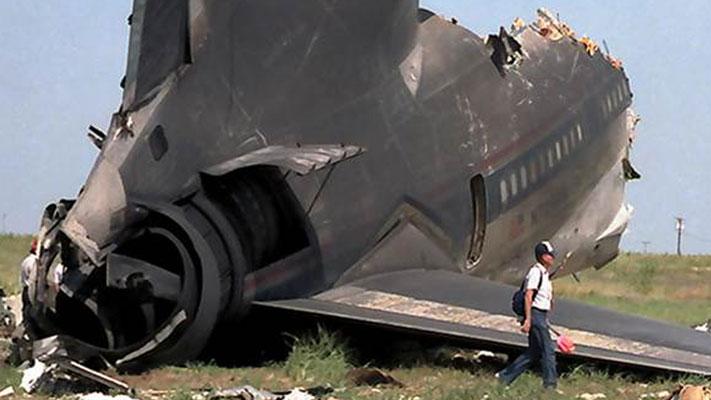Back to forecast
On This Day in 1975: Tragic Crash of Eastern Airlines Flight 66
June 23, 2021 at 08:33 AM EDT
By WeatherBug's Ali Husain

On June 24th, 1975, a tragic aircraft accident occurred at John F. Kennedy airport in New York City , when Eastern Air Lines Flight 66 crashed, killing 113 of the 124 persons on board.
The original accident report published by the National Transportation Board at the time states that the cause of the accident was “adverse winds associated with a very large thunderstorm,” and that this “resulted in a high descent rate [and that] the flight crew’s delayed recognition and correction were probably associated with reliance on visual cues rather than flight instrument references.” Additionally, the report states that the air control tower should have recognized the severe weather hazard along the flight path and closed the runway.
Preceding the arrival of Flight 66 at JFK was Flight 902. Transcripts of the communications from the air control tower show that Flight 902 reported extreme wind shear that pulled them right and down and forced them to pull back up into the sky. The captain of Flight 66 was recorded saying that Flight 902’s report was “asinine,” with an unidentified voice wondering aloud if “they [Flight 902] were just covering for themselves.”
Witnesses saw Flight 66 crash into a light tower, strike several more, caught fire, and then came to rest on Rockaway Boulevard. The plane was seen fighting through heavy rains, while drivers on Rockaway Boulevard about half a mile south of the accident site reported that there was no rain at their location when the crash occurred.
This accident led to the development of the low-level wind shear alert system in 1976, and the discovery of microbursts, a phenomenon that creates vertical wind shear and is a severe risk to aircraft. Meteorologist Tetsuya “Ted” Fujita (the creator of the tornado severity Enhanced Fujita Scale) was the one who investigated the conditions of Flight 66 and coined the microburst term. His theory wasn’t immediately accepted, but similar crashes in 1982 (Pan Am Flight 759 in New Orleans) and 1985 (Delta Flight 191 in Dallas-Fort Worth) helped convince the aviation community to eventually accept Fujita’s theory.
Worldwide training programs have since been implemented, alongside an onboard radar-warning system to detect wind shear threats. Doppler Radar stations are now installed at major airports, and pilots are required to take microburst and wind shear training courses and practice maneuvers in flight simulators. The last flight in the U.S. that can be blamed on a microburst was on July 2nd, 1994 in Charlotte, N.C., showing just how quickly air travel safety has improved.
Source: National Science Foundation, National Transportation Safety Board
--
Story Image: Delta Flight 191 at DFW
The original accident report published by the National Transportation Board at the time states that the cause of the accident was “adverse winds associated with a very large thunderstorm,” and that this “resulted in a high descent rate [and that] the flight crew’s delayed recognition and correction were probably associated with reliance on visual cues rather than flight instrument references.” Additionally, the report states that the air control tower should have recognized the severe weather hazard along the flight path and closed the runway.
Preceding the arrival of Flight 66 at JFK was Flight 902. Transcripts of the communications from the air control tower show that Flight 902 reported extreme wind shear that pulled them right and down and forced them to pull back up into the sky. The captain of Flight 66 was recorded saying that Flight 902’s report was “asinine,” with an unidentified voice wondering aloud if “they [Flight 902] were just covering for themselves.”
Witnesses saw Flight 66 crash into a light tower, strike several more, caught fire, and then came to rest on Rockaway Boulevard. The plane was seen fighting through heavy rains, while drivers on Rockaway Boulevard about half a mile south of the accident site reported that there was no rain at their location when the crash occurred.
This accident led to the development of the low-level wind shear alert system in 1976, and the discovery of microbursts, a phenomenon that creates vertical wind shear and is a severe risk to aircraft. Meteorologist Tetsuya “Ted” Fujita (the creator of the tornado severity Enhanced Fujita Scale) was the one who investigated the conditions of Flight 66 and coined the microburst term. His theory wasn’t immediately accepted, but similar crashes in 1982 (Pan Am Flight 759 in New Orleans) and 1985 (Delta Flight 191 in Dallas-Fort Worth) helped convince the aviation community to eventually accept Fujita’s theory.
Worldwide training programs have since been implemented, alongside an onboard radar-warning system to detect wind shear threats. Doppler Radar stations are now installed at major airports, and pilots are required to take microburst and wind shear training courses and practice maneuvers in flight simulators. The last flight in the U.S. that can be blamed on a microburst was on July 2nd, 1994 in Charlotte, N.C., showing just how quickly air travel safety has improved.
Source: National Science Foundation, National Transportation Safety Board
--
Story Image: Delta Flight 191 at DFW